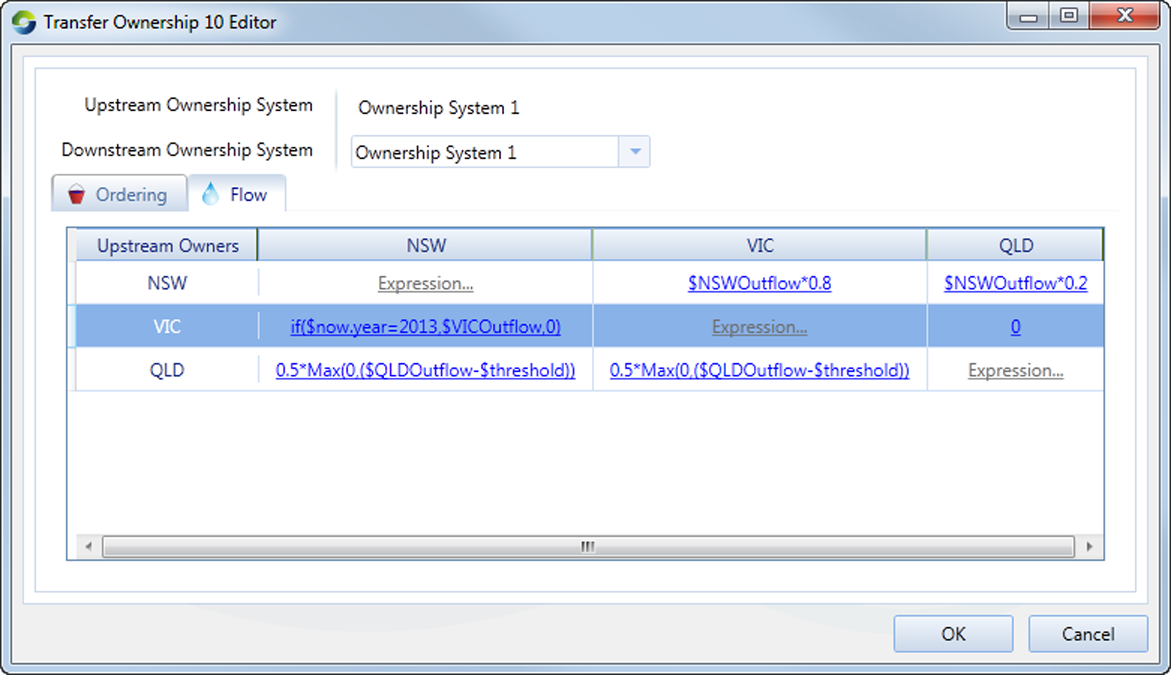Transfer Ownership node
Modelling water ownership throughout river systems allows you to determine how much water a particular owner has and where it is currently located. The transfer ownership node has two main functions in ownership systems:
To manage the transfer of flow between owners at a given point in an ownership system; or
To act as a boundary between adjacent ownership systems by managing the transfer of orders and flow at the boundary.
Once ownership has been enabled for a scenario, the Transfer Ownership Node can be setup to determine how water downstream of the node will be shared. It can be configured as either a:
Boundary node - marks ownership system boundaries and transfers 100% of flow from upstream to the downstream owners. Orders may or may not be allowed to pass upstream through the boundary, the modeller determines whether this occurs for each downstream owner. Where a downstream owner’s orders are to ‘cross the boundary’, 100% of the total order must be passed upstream. The modeller will determine the percentage of the downstream owner’s total order to transfer to each upstream owner. Note that an upstream owner may receive orders from multiple downstream owners; or
In-System Node - allows you to specify a transfer of flow ownership between owners at a particular location to reflect regulatory requirements that could operate under certain conditions. For example, an owner may receive additional flow over summer, or when there is flow above a given threshold. As regulatory requirements vary between jurisdictions and may change over time, you can define expressions to represent the conditions of flow transfer.
Note that when configured as an in-system, it is possible that only some owners transfer flow, and likely that only some of their flow is transferred. It is possible that the required transfer exceeds an owner’s share of the total flow. When this occurs, the transfer must be limited to the owner’s flow volume.
Configuration in Source
You can use the node’s feature editor to specify the orders made by owners, which travel from the bottom to the top of the network. You can also define how flow will be distributed amongst owners in different ownership systems. It travels from the top to the bottom of the network, and is hence, conceptually the opposite of orders.
Orders
This tab allows you to transfer the ownership of orders as they propagate upstream. It dictates how orders will be transferred between upstream and downstream owners for a given downstream ownership system. For the example shown in Figure 1 ,the Owners A, B, and C will each transfer equal amounts of their orders to owners 1, 2, and 3.
Figure 1. Transfer Ownership node, Ordering

Flow
Just as with ordering, the Flow tab (Figure 2) allows you to transfer ownership of flow as it travels down the network for a given downstream ownership system. Figure 2 shows a transfer ownership node that has been configured as an in-system node with the following conditions:
- NSW will always transfers 80% of their outflow to VIC, and 20% to QLD at this node;
- VIC will transfer all its outflow to NSW for the year 2013; and
- When QLD has flow above a threshold, 50% of its outflow will be transferred to NSW and the other 50% to VIC.
Figure 2. Transfer Ownership node, Flow

